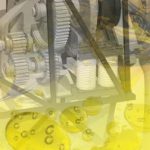When the Southwesterly winds blow out here in Texas—which is all day, every day—taking a planned outage to maintain your 120 megawatt wind farm is probably not going to happen. During the summer months, when the demand for electricity is at its highest and the demand for the reliability of these machines is even higher, planning a maintenance program to increase or even just maintain minimum levels of reliability and safety with a “No Outage Allowed” set of rules in place becomes quite complex very quickly. Figure 1
So what is the wind farm O&M electrical engineer to do? Fortunately, there’s a fairly simple answer: Develop a detailed no-outage maintenance plan based on good national consensus standards that have tried and true, recognized industry practices utilizing qualified and certified testing personnel.
Maintenance Terminology
Developing an “online” or “predictive maintenance” program isn’t easy. Finding the right folks to safely work in the program is even harder. Keeping up with data and understanding data trending, machine/equipment failure modes, and changing how often you should test based on all the above can be a stressful situation indeed. Development of the predictive program will be based on key components:
Reliability centered maintenance: RCM is the establishment of safe, cost-effective, minimum levels of maintenance, changes to operating procedures and strategies, and the establishment of capital maintenance regimes and plans. RCM typically utilizes predictive maintenance routines that constantly monitor conditions, typically performed when the equipment is online, or in service. RCM also concentrates on the monitoring and correction of root causes to equipment failures, also known as “root-cause-analysis.”
Predictive maintenance: PdM is the process of evaluating the condition of equipment by performing periodic or continuous (online) equipment condition monitoring. Basically, predictive maintenance differs from preventive maintenance by basing the maintenance need on the actual condition of the machine rather than on a preset schedule. PdM is typically performed when the equipment is online or in service.
Safety is Central
For the wind industry, money has always been tight and budgets squeezed. In recent years, however, wind has expanded at a rapid pace, and for the electrical construction contractor and the new generation of wind farm electrical workers things were exciting, and oftentimes chaotic. Most of these workers had never been exposed to the hazards that the wind turbine and collector system present, and most of them still have very little knowledge of the toxicity of electricity. In the last several years the wind industry has found value with proper engineering on the front end of a project, including acceptance testing and commissioning of the electrical power system components prior to initial energizing. Complete acceptance testing and commissioning of wind farms ensures a smooth startup and reduces the number of problems that can keep the site from coming—and staying—online. Many studies have shown that routine maintenance, including testing of electrical distribution equipment, has increased reliability and minimized downtime for commercial and industrial facilities, and these same philosophies hold true for wind farms.
The same can be said about protecting electrical workers who operate or work on energized electrical equipment, as we now can calculate that the incident energy produced by an arcing fault is proportional to its operating time. This aspect of incident energy means that proper maintenance and testing of the over-current protective devices (OCPD) is not only an operational issue, but also a safety issue. With this said, the very nature of maintaining an operational wind farm has some unique hazards typically not found in the commercial or industrial workplace.
Planning Maintenance
When developing a reliability based maintenance program the consideration of equipment condition, environment, loading, criticality, and reliability must be determined. Other factors including long-term trending, auditing, and staying abreast of changes in standards. Methods of testing and evaluation must be considered as well.
One should develop these programs based on national consensus standards to bring credibility to the program. Suggested sources are the IEEE STD 902-1998 (Yellow Book): IEEE Guide for Maintenance, Operation and Safety of Industrial and Commercial Power Systems; NFPA 70B: Recommended Practice for Electrical Equipment Maintenance; or the InterNational Electrical Testing Association (NETA) MTS-2007: Standard for Maintenance Testing Specifications for Electrical Power Equipment and Systems. The NETA testing standard also offers guidelines for the frequency of maintenance tests within “Annex B” of the document.
Some of the more common PdM tasks with the wind industry involve very cost-effective and simple tasks performed on a monthly or quarterly basis. Though performing these services online can present additional risks and hazards that must be accounted for, the overall impact to operations is minimal, and typically outages and downtime are not required.
Many PdM tasks are simple to implement, and PdM routes and routines are fairly straightforward to develop and sustain. In order to have a successful PdM program you must have the ability to compare the current readings to either a previously collected set of readings, or develop to a set of alarm limits. We want to see how the heat, motor signatures, vibration, and oil data patterns have changed from previously obtained data.
Technicians performing electrical tests and inspections should be trained and qualified to understand the hazards associated with operating, switching, and maintaining electrical power equipment. These individuals shall also be trained, experienced, and capable of conducting the cable testing and evaluating the test data, and they must be able to make an informed judgment on the continued serviceability or non-serviceability of the equipment under test.
Utilizing an independent third-party testing contractor is the only method of determining the long-term usage of the electrical equipment and its suitability for the intended purpose. Selection of a qualified contractor with an industry recognized “electrical testing accreditation,” such as InterNational Electrical Testing Association (NETA) accreditation, will help to ensure that a qualified and competent testing organization will perform the cable testing. Regardless of who you use, proper due diligence to the testing contractors capabilities and qualifications is essential.
Maintenance Methodologies
Infrared scanning: Infrared scanning (IR) accurately identifies the presence of abnormal heat in electrical and mechanical systems, which can help predict equipment trouble. The infrared (thermographic survey) process gives you a detailed thermal and photographic record of any problems detected, so you can take action before breakdowns occur. Typical inspection routines discover issues with roller and ball bearings, shaft/coupling alignment, loose cable and control wire terminations, generator core iron, windings, electrical connections, electrical insulation, and commutator/brush assemblies. The same technology and methodology used in the turbine is also used in the collector system to identify thermal issues in electrical components as well as the step-up transformer insulating oil flow/level, collector cabling connections/terminations, and generator circuit breaker connections.
Infrared cameras have significantly come down in cost over the last few years that many sites are purchasing their own camera for the routine scanning of the equipment and to troubleshoot heating. Their use for the daily maintenance routines is simple. Training and qualifying the part-time thermographer is easier than ever and usually performed by the manufacturer’s representative in a few hours. Infrared scanning of these machines and collector equipment at least on an annual basis is extremely important. If the demand for reliability is higher than average an increase if frequency to twice annually, or even quarterly is justifiable.
Several factors can render an infrared camera unable to see electrical corona, which is the ionization of the air surrounding a high voltage component. They include conductor voltage, shape and diameter, and surface irregularities such as scratches, nicks, dust, or water drops, all of which can affect a conductor’s electrical surface gradient and its corona performance. The corona camera can detect insulation and connection issues associated with the higher voltage equipment in the collector substation and the interconnection substation.
An annual frequency of scanning the collector substation for corona is an acceptable practice. Corona scanning, combined with any ultrasound and partial discharge analysis, could yield valuable data about the health of the insulation system.
Since some extreme electrical hazards exist on the wind farm, some planning and documentation must be put into place on dealing with high hazard and high risk electrical work. It is extremely important that the qualifications of the testing contractor or employee be qualified to perform the task.
Prior installation of “infrared windows” will greatly reduce the risk of any exposures, and expedite the online testing program. These windows will allow the passage of the IR light, maintaining emissivity, and if correctly installed limit any reason to enter the equipment enclosure and exposing live buses for routine inspections, which in turn greatly reduces and/or eliminates the electrical hazard exposure.
Online generator analysis: Online testing offers an analysis on the entire circuit path from the generator T-leads to the stator for phase-to-phase resistance, inductance, impedance, and current imbalance which is used to determine if turn or phase shorts are present, as well as faulty connections. The test can also identify cracked or broken rotor bars, porosity, and high resistance connections on the end rings through motor current signature analysis, and a rotor influence check. Many mechanical issues such as bowed shafts, cocked end rings, and degraded bearing journals create magnetic imbalances that can be detected, as well.
Since this methodology calls for the direct interaction of personnel with an energized and operating generation system, it is extremely important that the testing contractor or employee be qualified to perform the task. Prior installation of motor test access panels (MTAPS) will reduce the risk of any exposures and expedite the online testing program. These boxes allow the routing of the leads from the coupling capacitors and sensors to be brought outside the equipment. This will mitigate exposure to the electrical hazards and offers a low risk environment to perform the sampling. Typical frequencies for this activity are usually performed on an annual basis, but should be performed quarterly to offer the results and reliability, since this is one of the larger costs associated with your predictive.
Vibration analysis: Vibration on rotating apparatus can be very destructive. These vibrations can be caused by imbalances on the rotating parts, the meshing of gear teeth, bearing loading, coupling alignment, and footing issues.
Very few of the turbines currently installed have permanently mounted online vibration monitoring systems. This means that almost all of the vibration data collection and analysis that is performed used a portable data collector, and the data is entered into a database program. This program, though effective and a great solution for preventing bearing failures, does provide for some challenges due the large number of points to be monitored each period. This means that an average 80-turbine site could have as many as 400 or more vibration points. When you consider taking vertical and horizontal readings at each bearing and one axial reading on each machine case, the numbers add up quickly.
Lubrication grease and oil analysis: Sampling and analyzing bearing greases and oil lubricants determine the properties of the lubricant for additives, base oil composition, and issues such as contaminants and debris from premature gear or bearing failures. Tracking oil analysis sample results over the life of a particular machine can be trended to eliminate costly repairs.
Lubrication sampling, testing, and analysis is one of the least expensive line items in the maintenance budget, but is the most underutilized methodology of the predictive technologies. The standard practice for sampling of the lubricants is annually, but increasing the frequency to two or even three times a year will offer a premium return on the reliability of rotating apparatus.
Transformer insulating oil sampling and analysis: The majority of power transformers in operation at wind farms are filled with mineral oil. The primary function of the oil is to provide a high dielectric insulating material and an efficient coolant to dissipate heat.
The effectiveness of the oil as an insulating material is reduced as the moisture level increases, while cooling is reduced as the oil oxidizes. The paper insulation will also absorb moisture from the oil. An analysis of the levels and ratios of dissolved combustible gases in electrical insulating fluids is a very effective tool to diagnose potential problems in the transformer caused by loose connections, overloading, arcing, hot spots, and case or seal leaks that let moisture or atmosphere enter the unit.
Transformer insulating oil sampling, testing, and analysis is another one of those inexpensive line items in the maintenance budget. Average costs typically range from $150-$250 for an oil quality and dissolved gas-in-oil test. The prices differ based on the desired battery of tests included in the program. The collector transformers should be sampled on an annual basis, while the collector substation transformers could stand an increase in frequency to twice annually, and possibly three times per year based on the number of load tap changer operations. The more critical the component, the more often you should test.
Collector System
Partial discharge sampling and analysis: PD is a localized electrical discharge that only partially bridges the insulation between conductors. PD is a phenomenon that occurs inside cable insulation within imperfections, resulting from cable aging such as thermal, mechanical, and electrical stresses.
Because a significant percentage of cable failures are associated with partial discharge, cable systems are typically tested after installation for craftsmanship and other related problems that can cause partial discharge. Online PD testing provides crucial information on the integrity of an electrical system. Partial discharge can be located, measured, and recorded, helping to identify cables, switchgear, and transformers that are close to failure.
Online partial discharge testing: PD or online testing is performed while the equipment is energized at normal operating voltages with a snapshot in time sample pulled and sent to a third party laboratory for analysis. The testing is conducted during real operating conditions, under typical temperature, voltage stresses, and vibration levels. It is a nondestructive test and does not use over voltages that could adversely affect the equipment. “Online partial discharge testing” is relatively inexpensive compared to offline testing that requires interruption of service and production. This methodology detects and locates some accessory and a few cable defects, but can detect failures in other areas; i.e., switchgear and bus.
Similar hazards exists as discussed earlier in the online generator testing discussion. When direct interaction of personnel with an energized and operating generation system may occur, it is extremely important that they are qualified to perform the task. Prior installation of “PD boxes” or cable/equipment test access panels will reduce the risk of exposure and expedite the online testing program. These boxes allow the routing of the cable/equipment shields or RF current transformers leads outside the equipment and mitigating exposure to the electrical hazards, and creates a low risk environment to perform the sampling.
Summary
As many of these wind farms come out of their warranty periods, maintenance is a must, but finding qualified employees and contractors to perform these routine tasks is becoming evermore difficult due as the aging workforce and the lack of the younger workers moving in to replace retiring workers exacerbates the problem.
For the wind farm, following predictive maintenance strategies implemented by the industrial sector will offer a higher level of reliability, along with protecting the company’s assets. Predictive and preventive programs can also help address the compliance requirements with NERC/FERC regulations. Follow-up with a regimented routine preventive testing and inspection program and further enhance the predictive maintenance program. Develop a well-defined and regimented predictive and preventive maintenance plan with reporting and trending capabilities, and improved reliability will follow, as well as less worry and enhanced peace of mind.








































